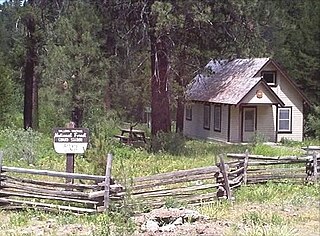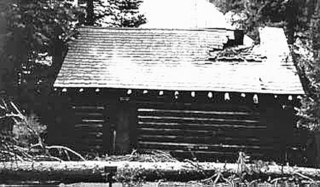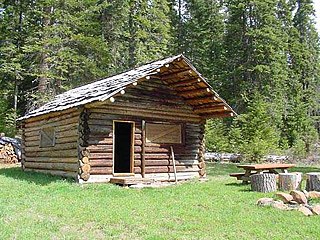
The Cascade Canyon Barn was designed by the National Park Service to standard plans and built by the Civilian Conservation Corps in 1935. The National Park Service rustic style barn is 5 miles (8 km) west of Jenny Lake in Grand Teton National Park in the U.S. state of Wyoming.

The Antlers Guard Station is a rustic cabin located in the Wallowa–Whitman National Forest in northeastern Oregon, United States. It was originally built to house fire crews assigned to patrol the surrounding National Forest. Since the 1990s, the United States Forest Service rents Antlers Guard Station and other forest cabins and lookout stations to recreational visitors. The Antlers Guard Station is listed on the National Register of Historic Places.

The Musick Guard Station is a rustic cabin located in the Umpqua National Forest in western Oregon, United States. It was originally built to house fire crews assigned to patrol the surrounding National Forest. In the 1990s, the United States Forest Service began renting Musick Guard Station to recreational visitors. The Musick Guard Station is listed on the National Register of Historic Places.

The Imnaha Guard Station is a rustic cabin located in the Rogue River-Siskiyou National Forest in western Oregon, United States. It was originally built to house fire crews assigned to patrol the surrounding National Forest. In the 1990s, the United States Forest Service began renting the Imnaha Guard Station to recreational visitors. The Imnaha Guard Station is listed on the National Register of Historic Places.

The Death Canyon Barn is a combination barn and ranger patrol cabin in Grand Teton National Park. The barn was built in Death Canyon on the Death Canyon Trail at its junction with the Alaska Basin Trail by the Civilian Conservation Corps in 1935 in the National Park Service rustic style. Located with a clear view of Prospector Mountain, it shares a common style and purpose with the Cascade Canyon Barn to the north in the park, with minor differences attributable to available materials and the preferences of the work crews building the barns.

The Moran Bay Patrol Cabin was built by the Civilian Conservation Corps about 1932. The log structure was located in the northern backcountry of Grand Teton National Park, and was built to a standard design for such structures, in the National Park Service Rustic style, but for the U.S. Forest Service, which administered much of the area prior to the expansion of the park in 1943. The Upper Granite Canyon Patrol Cabin is similar.

The Upper Granite Canyon Patrol Cabin was built by the Civilian Conservation Corps about 1935. The log structure is located in the extreme southwest backcountry of Grand Teton National Park. The cabin was built according to a standard design for such structures, in the National Park Service Rustic style. The Moran Bay Patrol Cabin is similar.

The Rosencrans Cabin is part of a small historic district comprising five log buildings on three acres in Bridger-Teton National Forest, just east of Grand Teton National Park. The cabin was used by Rudolph "Rosie" Rosencrans, who played a role in the development of Teton National Forest and who later became a U.S. Forest Service administrator in the early 20th century. Rosencrans was buried at this location.

The UXU Ranch is a historic dude ranch in Shoshone National Forest near Wapiti, Wyoming. The ranch began as a sawmill, as early as 1898. In 1929 Bronson Case "Bob" Rumsey obtained a permit from the U.S. Forest Service to operate a dude ranch on the property, using the sawmill headquarters building, a lodge, and tent cabins. Most of the current structures were built in the 1920s and 1930s from lumber milled on the site.

The Anderson Lodge or Anderson Studio was built in 1890 in the Absaroka Mountains west of Meeteetse, Wyoming, in what was then the Yellowstone Park Timber Land Reserve, soon renamed the Yellowstone Forest Reserve. The two-story rustic log structure became the home of rancher and artist Abraham Archibald Anderson from 1901 to 1905. Anderson played a significant role in the development of the forest reserve as Special Superintendent of Forest Reserves, and the Anderson Lodge was used as an administrative building for the forest.

The Clackamas Lake Ranger Station Historic District is a Forest Service compound consisting of eleven historic buildings located in the Mount Hood National Forest in the Cascade Mountains of northern Oregon. It was originally built as a district ranger station for the Clackamas Lake Ranger District. It was later converted to a summer guard station. Today, the Forest Service rents the historic ranger's residence to recreational visitors. The Clackamas Lake Ranger Station is listed as a historic district on the National Register of Historic Places.

The Willow Prairie Cabin is a rustic one-room cabin located in the Rogue River-Siskiyou National Forest in western Oregon, United States. It was built by a road construction crew in 1924. When the road was finished the United States Forest Service began using it to house fire crews assigned to patrol the surrounding National Forest. The Forest Service now rents the cabin to recreational visitors. The Willow Prairie Cabin is listed on the National Register of Historic Places.

The Allison Ranger Station is a Forest Service compound consisting of eight rustic buildings located in the Malheur National Forest in the Ochoco Mountains of eastern Oregon. It was originally built as a district ranger station for the Snow Mountain Ranger District. It was later converted to a summer guard station. Today, it is an active Forest Service guard station with a crew of twelve fire fighters on station during the summer fire season. The ranger station's oldest building, the Donnelly Cabin, is currently listed on the National Register of Historic Places. Most of the other buildings at the Allison Ranger Station are eligible for historic designation, but are not yet listed on the national register.

The Enchanted Valley Chalet is a backcountry lodge in Olympic National Park. The chalet was built in 1931 by Tom E. Criswell, his son Glen and the Olson family of Quinault whose Olympic Recreation Company operated it as a destination lodge deep up the Quinault River Valley, about 13 miles (21 km) from the nearest road access. Under the Olsons' ownership through the 1930s, and for decades under the National Park Service, the chalet has endured as a destination in its own right. It was a popular destination for hikers and horse tours through the 1940s. In 1943, the chalet was closed as an accommodation. It was used for a short period as an Aircraft Warning Service station during World War II, watching for Japanese airplanes. It did not reopen until 1953, after the National Park Service had purchased the Olympic Recreation Company's holdings in 1951, having purchased the Chalet itself in 1939. After a period of neglect, the chalet was restored in 1983-84. It was one of four such accommodations built by the Olympic Recreation Company and the Olympic Chalet Company; Low Divide Chalet, Nine Mile Shelter, Graves Creek Inn and the Enchanted Valley Chalet. Of the four, only the Enchanted Valley Chalet and the bathhouse at Low Divide remain.

The Thunder Lake Patrol Cabin is a small structure in Rocky Mountain National Park, Colorado. Built in 1930, the 12-foot (3.7 m) by 16-foot (4.9 m) cabin may have been built as a simple shelter, but has more recently been used on an occasional basis as a backcountry patrol cabin in the Wild Basin area. The one story one-room log cabin is not used in the winter, but does have a stove with a stone fireplace. The main cabin is gable-roofed, with a small shed-roofed porch, and is a good example of the National Park Service rustic style. The logs are saddle-notched, projecting an increasing distance at their ends from top to bottom.

The Elkhorn Guard Station, also known as the Elkhorn Ranger Station, comprises four buildings in the backcountry of Olympic National Park, Washington. The station was built by the U.S. Forest Service between 1930 and 1934, before the establishment of the national park, when the lands were part of Olympic National Forest (USFS). The structures were designed in the Forest Service's interpretation of the National Park Service rustic style, using native materials and construction techniques. The complex was built using labor from the Public Works Administration and the Civilian Conservation Corps. The Elkhorn Guard Station is one of five surviving USFS-built guard stations.

The Horseshoe Lake Ranger Station in Lassen Volcanic National Park, California is a backcountry ranger station that was built by Civilian Conservation Corps labor in 1934. The cabin typifies National Park Service standard designs for such structures in the prevailing National Park Service Rustic style then used by the Park Service. It is the only such example of a standard-plan backcountry ranger station in Lassen Volcanic National Park. There were originally two structures at the site, the residence, and a now-vanished barn.

The Lower Windy Creek Ranger Cabin No. 15, also known as Lower Windy Creek Patrol Cabin and Lower Windy Shelter Cabin, is a historic backcountry shelter in the Denali National Park & Preserve, in Alaska. It is built out of peeled logs, sealed with oakum and concrete chinking. It has a medium-pitch gable roof of corrugated metal and shiplap. The site includes seven log shelters for dogs, located about 70 feet (21 m) north of the cabin. The cabin is located about 500 feet east of Mile 324 on the Alaska Railroad.

The Elk Lake Guard Station is a United States Forest Service cabin located in the Deschutes National Forest southwest of Bend, Oregon. The guard station was built in 1929 on the north shore of Elk Lake. It was used as a home base for Forest Service personnel who protected forest resources, maintained facilities, and aided summer visitors in the Cascade Lakes area of Central Oregon. After decades of use, the cabin was renovated in the late 1990s. Today, the historic guard station serves as a Forest Service visitor information center along the Cascade Lakes Scenic Byway. The Elk Lake Guard Station is listed on the National Register of Historic Places.

The Jack Creek Guard Station is a ranger patrol cabin in Medicine Bow National Forest in Carbon County, Wyoming. The one-room log cabin was built by U.S. Forest Service district ranger Evan John Williams in 1933-34. It was built to Forest Service Plan A-4, featuring half-dovetailed corners and a deep front porch with a gabled wood shake roof. A stove is vented through a brick chimney at the back of the cabin.


















